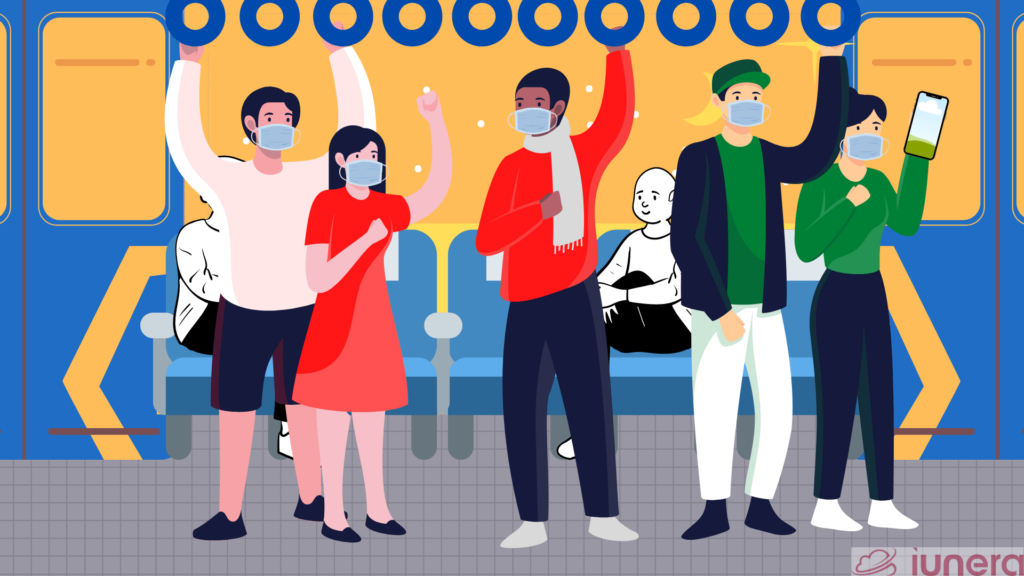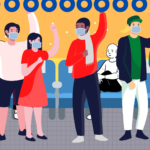This post is also available in: Deutsch (German)
People have a fear of Covid-19 infections in public transport. But is this fear really justified? What is the likelihood that someone will get infected in public transport?
The risk level of Covid-19 infections in public transport
In the past year, several studies about how likely someone will catch a Covid-19 infection in public transport have been recorded and published. One of them was “Clusters of Coronavirus Disease in Communities” by Yuki Furuse et al, published in September 2020 on Emerging Infectious Diseases.
Between January and April 2020, the researchers analysed 3,184 Covid-19 cases in Japan and identified 61 clusters in healthcare facilities, other types of care facilities, restaurants, bars, workplaces, music events, gyms, ceremonies and an aeroplane. What about public transport? None.
Any mention of public transport cases was also nowhere to be found in a June 2020 report about Covid-19 clusters by Santé Publique France (France’s public health agency). Table 1 in this report showed that there were zero clusters in transport, reinforcing the conclusion that none of the Covid-19 clusters in France thus far were connected to public transport.

How was this possible? Here are some answers.
Published in July 2020, a team of scientists from the University of Southampton collaborated with the Chinese Academy of Sciences, China Academy of Electronics and Information Technology, and Chinese Centre for Disease Control and Prevention to study the risk of Covid-19 infections in a train carriage carrying an infectious person.
Using anonymised data from China’s high-speed G train network between December 2019 and March 2020, the team discovered that proximity between the passengers and their shared travel time can make a difference in the spread of Covid-19. The risk decreased with increasing distance but increased with increasing shared travel time.
- Train passengers sitting next to an infected passenger had a 3.5% risk of getting infected while those on the same row had a 1.5% risk.
- A funny finding was that only 0.075% of passengers who used a seat previously used by an infected passenger were infected.
- Overall, the risk increased by 0.15% for every hour of shared travel.
- For passengers in nearby seats, the risk increased by 1.3% for every hour of shared travel.
Interestingly, Dr David Green, Dr Jie Zhou and Carl Desouza took 20 samples of frequently-touched surfaces and air every month between September and December 2020 in London’s public transport network. And guess what? Their tests found no traces of the SARS-CoV-2 RNA that they expected to find. NONE, which the research team attributed to the enhanced cleaning approaches by the public transport system, widespread mask-wearing and lower occupancy levels during sampling.
“In some cities, public transport operators are employing sanitization and physical distance policies for passengers such as staggered seating.”
Madan Regmi, the Economic Affairs Officer of the United Nations Economic and Social Commission for Asia and the Pacific (UNESCAP).
However, let’s not get our hopes up so much, as there is another factor to consider: ventilation. A 2018 paper by Goscé and Johansson titled “Analysing the link between public transport use and airborne transmission: mobility and contagion in the London underground” found a connection between the use of the London underground and the spread of influenza-like illnesses (ILI), due to the crowded and confined nature of the underground train network.
Echoing the above findings was a June 2020 South African Medical Journal rapid review paper titled “Transmission of respiratory viruses when using public ground transport“:
“Findings from this review suggest that the use of public transport increases the risk of viral transmission owing to the correlation between recent use of public transport and presentation of influenza symptoms, and that risk of transmission increases with an increase in trip duration and proximity to an infected individual.
The review also identified two modelling studies suggesting that adequate ventilation could reduce the probability of passengers contracting a viral respiratory infection from an infected passenger.”
An excerpt from the concluding remarks of “Transmission of respiratory viruses when using public ground transport: A rapid review to inform public health recommendations during the COVID-19 pandemic” by Zhen, Chan, Schoonees, Apatu, Thabane and Young (2020).
So, is it safe to take public transport during Covid-19?

Yes, it is safe to take public transport now, but with the following conditions:
- You’re sitting or standing far away from any other passenger.
- The occupancy levels allow you to sit or stand far away from the others.
- You’re not sharing a ride with the same stranger for long periods of time.
- You’re wearing your mask properly.
- You’re keeping your hands clean.
- The vehicles are being cleaned properly and regularly.
- The vehicles are well-ventilated.
One of the most successful campaigns was by the Nairobi-based Maroon Commandos Band of the Kenya Army – Lang’ata Barracks – which released captivating songs calling upon Kenyans to abide by these measures.
In one popular song, Army Commandos describe the importance of personal protective measures as weapons against COVID-19:
‘Silaha jamaa, tuoshe mikono, maji safi na sabuni, sanitiza mara kwa mara … barakoa inaokoa, hakikisha umevalia yako (the weapons people: wash your hands, with clean water and soap, sanitize often … a face mask saves, ensure you wear it)’.
Duncan Njue of FCG Kenya described a campaign song in his LSE article about Kenya’s responsibility in defeating Covid-19.
It’s safe to say that public transport is safe when passengers are allowed to social distance, minimise shared travel times, cover their noses and mouths properly, sanitise their hands and apply other necessary measures. That’s why it’s so important for both public transport operators and passengers to cooperate with each other. Public transport operators are responsible for implementing the standard operating procedures (SOP) and making adjustments to the operations while passengers need to follow the SOP carefully.
Public transport operators’ role
How can public transport operators help in keeping passengers safe from Covid-19?

- Provide occupancy data to help passengers determine the best time to travel and avoid crowded vehicles, made possible by the many options of people counting methods that can help gather occupancy data in public transport.
- Make social distancing easier by increasing the frequency of buses and trains as well as setting an occupancy limit.
- Make sure the public transport vehicles are well-ventilated so that the passengers are not stuck breathing the same air.
- Clean the interiors of the vehicles frequently and properly, especially the seats, poles, handrails, lift buttons and restroom surfaces that are often touched by different passengers.
- Equip the train and bus stations with sanitisers, soaps and contactless devices. Contactless devices are needed to ensure that passengers do not have to touch surfaces like kiosks, ticket machines, station gates/turnstiles, handrails, lift buttons and rubbish bins.
Passengers’ role
How can passengers travel without getting or spreading Covid-19?

- Avoid non-essential travel, especially if you’re sick. If you can work from home, please work from home.
- But, if you must travel, find the best time to travel like off-peak hours. This is where occupancy data (as mentioned earlier) can come in handy. If you have to travel to work, be sure to ask your boss for staggered working hours to avoid peak hours.
- Wait for a less-crowded vehicle.
- Always wear your mask properly in public spaces by covering your nose and mouth.
- Always social distance by sitting or standing at least 6 feet away from other people.
- Just to be extra careful, avoid touching surfaces like poles (and then touching your face), even if the operators do a good job in cleaning.
- But, if you must touch surfaces (like holding a pole or handrail for support), sanitise! Use a hand sanitiser with at least 60% alcohol (not the edible kind). Once you’re home or in the office (or any place with a sink), wash your hands with water and soap for at least 20 seconds. When you reach home, it’s best to toss your clothes into the laundry basket and shower immediately.
- While riding public transport, avoid talking, eating and drinking. The no-eating/drinking rule in public transport is easier to follow in places that already have this rule, but zipping your mouth shut is a measure that should be taken into serious consideration. If you’re hungry or thirsty, eat or drink when you are not using public transport and situated far away from occupied spaces.
“If you’re close enough to smell someone’s garlic breath on public transport, then you’re also potentially inhaling any virus that’s carried with it.”
Dr. Julian Tang, a clinical virologist at the University of Leicester, quoted by the BBC regarding proximity and enclosed airspace.
Better safe than sorry
These measures might seem obvious to you by now. But let this serve as a reminder to take these measures seriously to avoid undoing every early effort in preventing the spread of Covid-19.
In the current fight against Covid-19, an attitude as simple as complacency can be really dangerous. It’s the one big reason for the resurgence in Covid-19 cases as a minor loosening in restrictions has led most people here to feel like it’s okay to go out and disregard the social distancing rules.
But here’s the harsh truth: Covid-19 is still at large.
Therefore, the most important thing to remember is that all it takes to spread Covid-19 is just one person to infect another.
Related Posts
Read the article below to find out what we’re doing to help:
Check out more of our articles below:
